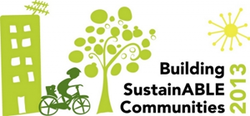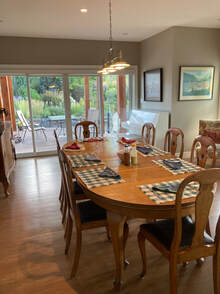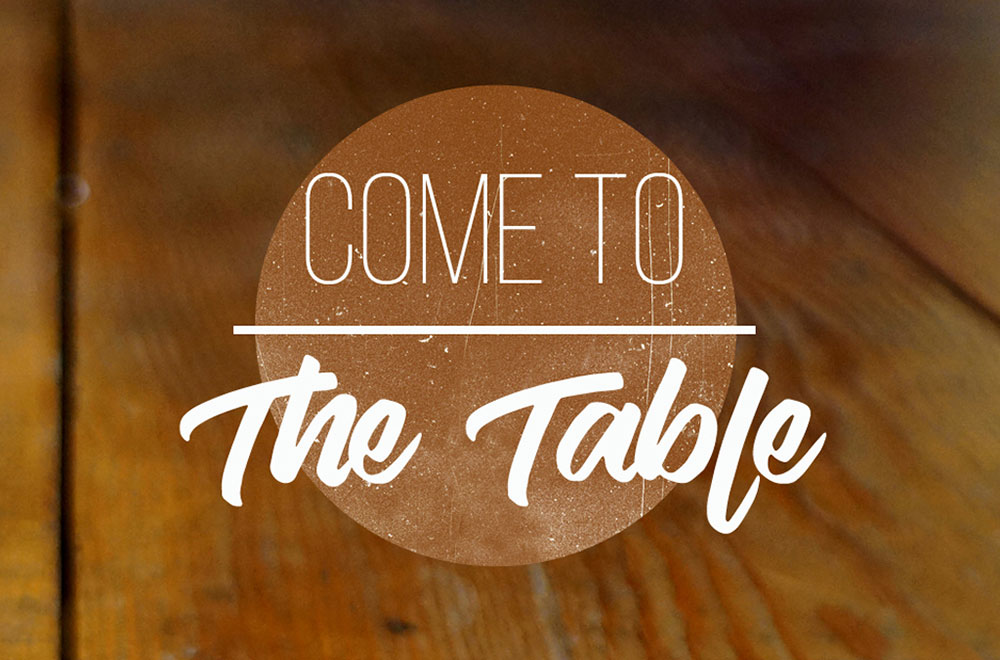Many Hands Make Light Work
| Carolyn Hoessler, April 2nd, 2023 The phrase many hands make less work delightfully applies to meals and post-dinner clean-up at Rare Birds. Let’s set the stage (or table) for this scene. At first, a pair of people or person cooks the meal. Then, as we sit together to share a delicious meal, a thank you, and a moment of celebrating this community around the table and the cook. Conversation and laughter are shared as freely as food is passed around the big table. The complexity and mundaneness of the world sloughs off between bites of hot dishes and the crunch of salad. The weight of the day disappears along with the heaps of food. We sit satiated, passing around the last bites, and setting aside leftovers for lunches. In time the first people cleared their plates, then more carry theirs to the kitchen. With two dishwashers, plates and cutlery quickly disappear below. Pots are washed, meals packed, the table cleaned, and floors swept – all within less time than it took to eat the kitchen is restored. Many hands indeed make more joy and less work. |
More than Just a Home
It has been 10 years since an intrepid group of like-minded folks forged ahead with an idea to create a new model for shared living. Innovative risk takers, they were people who saw possibilities. Early conversations included a common concern for the sustainability of the current North American aspirations of large, expansive single-family homes. The future’s looming crises of environment, economic and housing issues were coming into focus. In our passion for alternative solutions, our basic vision and shared values remain.
Over the years people have come and gone bringing new skills and ideas that have been incorporated. The dynamics change as well. Currently we are multigenerational and a younger demographic than when we began. We are always adjusting to the changes in the flow of life, with a common theme of letting go.
What surprises me are the persistent misconceptions. Commonly, people assume we are some kind of retirement home and that there is a lack of privacy. Neither are true. Currently, the average age of the 10 people who live at RareBirds is 43.9. This does include 2 children. Each shareholder has approximately 400 sq ft of private space with a full bath and beautiful views. There is 3,600 ft of common space. People enjoy the comfort of their private space and we have never heard of any concern about lack of privacy.
Also surprising is how tightly people hold on to the contemporary view of independence. The nuclear family in North American and European culture is only about 200 years old. A concept spawned with the Industrial Revolution. For centuries households were interdependent, consisting of parents, children, grandparents, widowed aunts or uncles, orphaned children. The growing concerns of housing, food and economic issues is putting pressure on this privileged era. With it comes a growing interest in cohousing.
The world we are stepping into requires more cooperation, innovation and flexibility. More kindness and compassion. A shared living model such as the RareBirds offers more abundance, more safety and more security. More home cooked meals shared with laughter.
For a $250,000 investment and an $800.00 monthly contribution to groceries and operational costs we live in a beautiful home with a menagerie of lovely people. How lucky is that?
by Mary Jordan March 6,2020
At the RareBirds’ home we come to the table for our evening meal.
A dinner bell calls us to the table from our rooms, the garden, a chore we may be engaged in.
It signals a time to disengage from emails, phone conversations or work distractions and come together at our table.
When everyone is at the table, we take hands. Perhaps there are two pair of hands reaching across the table or perhaps it is a table of 10 or more. We begin with gratitude to the cook and then the ritual words we have adopted. Thank you for the food before us, the people around us and the connections between us.
Coming to the table this way invites a sense of gratitude and connection that is a core value of our community.
Consistently people who have lived in this home, whether for weeks or years have articulated that our dinners together have been their favourite part of being with the RareBirds.
Over the years at the table we have shared our histories, our challenges, our disappointments, or our sadness or joy at a turn of our lives. We have also ranted at politicians and angst over the state of the world. Together we have fantasized solutions and habitually solved nothing.
At this table we have learned about and from each other. Even with people of shared values and world views, a discussion or a lecture we have heard, a film, a book or the morning headlines can offer a new perspective. Coming to the table, requires an openness to sharing more than the food we eat together.
Any table requires an openness.
Come to the table, come to our table. You may at times be challenged or frustrated but you will not be disappointed at the gems you will find at this table.
Listen, perhaps you are called to our table.

I am have been asked by many people intrigued with our project what our RareBirds Housing Co-operative project is all about- who are you? and what are you doing?… and why are you doing this?
It would certainly be very easy to quickly provide a ‘quick and easy’ statistical overview as a response to those questions.
The RareBirds are nine lively adults, three couples and three singles, or six co-op memberships in total between us.
We have been incorporated as a housing co-op for almost two years.
We are building a shared 6,000 sq. ft. three level house with a shared kitchen and living space.
The house is about 15 minutes walk west of the downtown core of Kamloops.
The total value of the project is $1.2 million. We are self-financed and each member invested $200,000. The house will be completed in February of 2014, we hope!
I could answer the question about who we are and what we are doing this simple way with these stats.
Or I could answer by giving more emphasis to the house itself. After all, the house is the most visible aspect of who we are and what we are doing.
Thus, the response might include some features of the sustainable design of the house and some of the environmental building practices that have gone into the construction. I might describe some of the technical details.
We have active and passive design elements to conserve energy and lessen our ecological footprint.
We paid close attention to the orientation of the house and how best to use the land.
The house is double insulated- both within and without the sheeting of the house reaching an R rating in the walls of R-27 and the roof of R-50 values.
A solar hot water system consisting of three panels and a 120 gallon storage tank will provide an average of 75 gallons of hot water per day.
There are 27 250 watt solar panels installed on our south facing roof with an array that is built to eventually provide a total of 45 panels. We are approved as one of about 270 BC Hydro net metering projects. Our system connects to the distribution system; we receive credit for the electricity we generate. These will generate a total of about 11 ¼ kilowatts of electrical energy or approximately $1200 per year of electricity at current utility rates.
We are using a heat pump for our heating and cooling.
By bringing together six typical Canadian households into one, we are able to reduce both our per person consumption of energy but also reduce the duplication of many day-to-day household items and equipment, such as household appliances.
So, I could answer these questions about who we are and what we are doing by referring to our approach to sustainable design and building.
One other option that is always available for a response is the story of how we got here.
It has been about a three year development.
That initial meeting of friends came about because some of our group had viewed a documentary: ‘how to boil a frog’. It was not a cooking film… it was a documentary about how to live more simply. Indeed, you could say that a slowly boiled frog drew the interest of some birds!
This prompted a desire to gather some other friends together to see if there might be an interest in a shared living arrangement. At this first meeting, the group only had a vague idea in mind- but soon a growing set of intentions and a common shared purpose was articulated.
We drafted a Living on Purpose document early on to help guide us:
PURPOSE:
The purpose of our Intentional Community is to create a model that will enable us to live into the possibilities of social and spiritual transformation.
INTENTION:
· To create more financial freedom and emotional enrichment for each of us by living interdependently, mindful of environmental responsibilities and sustainable practices in our community living.
· To create an inclusive environment that embraces our extended families and welcomes our friends
· To create sustainable practices which embody our values
That initial gathering was the nucleus of an emerging idea that gained clarity and scope as we met together for that first year.
We spent months of focused learning and research about the options of shared living; there are many models and experiments going on.
We settled on a combined/hybrid model of a registered self-financed equity housing co-operative and an intentional community with shared kitchen and cooking rather than independent living units.
We incorporated as a BC housing co-op in January 2012.
As we worked on our way-of-being together and we researched further aspects of common life, we started an active search for both a suitable property and additional members.
In July 2012, we purchased a ½ acre lot near the downtown core of Kamloops.
Our project was successful through public hearing and rezoning and after a process of design and approvals, the construction began in May.
We have our full membership and are now accepting interested people onto our waiting list.
We have also sold our homes along the way to provide financing for the project… thus, the period of house sitting and co-habitating with friends is at last coming to an end in a few months!
This is a quick scan of our story… but it still misses some of the heart of the answer to the questions:
Who are you? What are you doing? Why are you doing this?
I am grateful for the four simple words in the C4 Approach to Community SustainABILITY.
Opening them up this morning with you helps me to come closer to a deeper level of response.
Curiosity
Creativity
Communication
Collaboration
Curiousity
We are curious birds!
I have to admit that I do tend to prefer the word ‘wonder’ over ‘curiosity’. Curiosity is very valuable- it is a mental process of trying to know more and understand more… this is all good.
Yet, wonder is more of a heart word.
Wonder holds some of the mystery of life.
One of our touchstones that we refer to in our group decision process and sharing together is this:
“when the going gets rough, turn to wonder”
And we ask that question first about ourselves… I wonder why I am reacting in this way to what is going on?
Curiosity and wonder have been gifts to us along the way.
Creativity
We have accessed a few guides to help us along the way… someone to guide us through incorporating as a co-op, our architect to assist us with designing a building, a builder to help us construct the home… but we have mostly relied on our own creativity and pondering together to determine our way forward and to answer the most essential questions: who will you be and why are you doing this?
We realized early on that no consultant will be able to answer those questions for us.
One creative element that we have worked on is how we meet together in a circle process and in consensus decision making. This process of deep listening, silence and careful practice is still evolving and fine tuning but it has served us well.
Communication
Nine people using the same kitchen… each member cooking for the house one night each week… coordinating groceries, chores, guests, and events…
Do I need to say more about the value of communication?!!
We have also been aware of how valuable it has been to communicate not only internally but with the broader community: in telling our story.
Telling stories is powerful.
We find out that a crazy scheme over a glass of wine with friends just might be actually taking place somewhere… maybe even in our own city.
So we are making an effort to communicate our story, as much as we can.
Find us on Facebook!
Collaboration
I have been reading some of the writings of Peter Block recently. Peter is an American writer and social thinker who has reflected on what it means to create community.
He believes that when people truly collaborate they are accessing latent resources that already exist among them.
It is not just making decisions.
It is an energy release- an activation of gifts hidden from view or ignored or underestimated.
This has been our experience as we navigated through a myriad of decisions.
Thank you for the opportunity to share this morning. If you are in Kamloops and would like a cup of coffee and a tour of the home, please contact us via our website or by talking with us today.
We would love to know what you are doing, as well.
That is after February when we are moved in… unless you have experience in building retaining walls, then you can come next week and bring a pair of gloves too!


